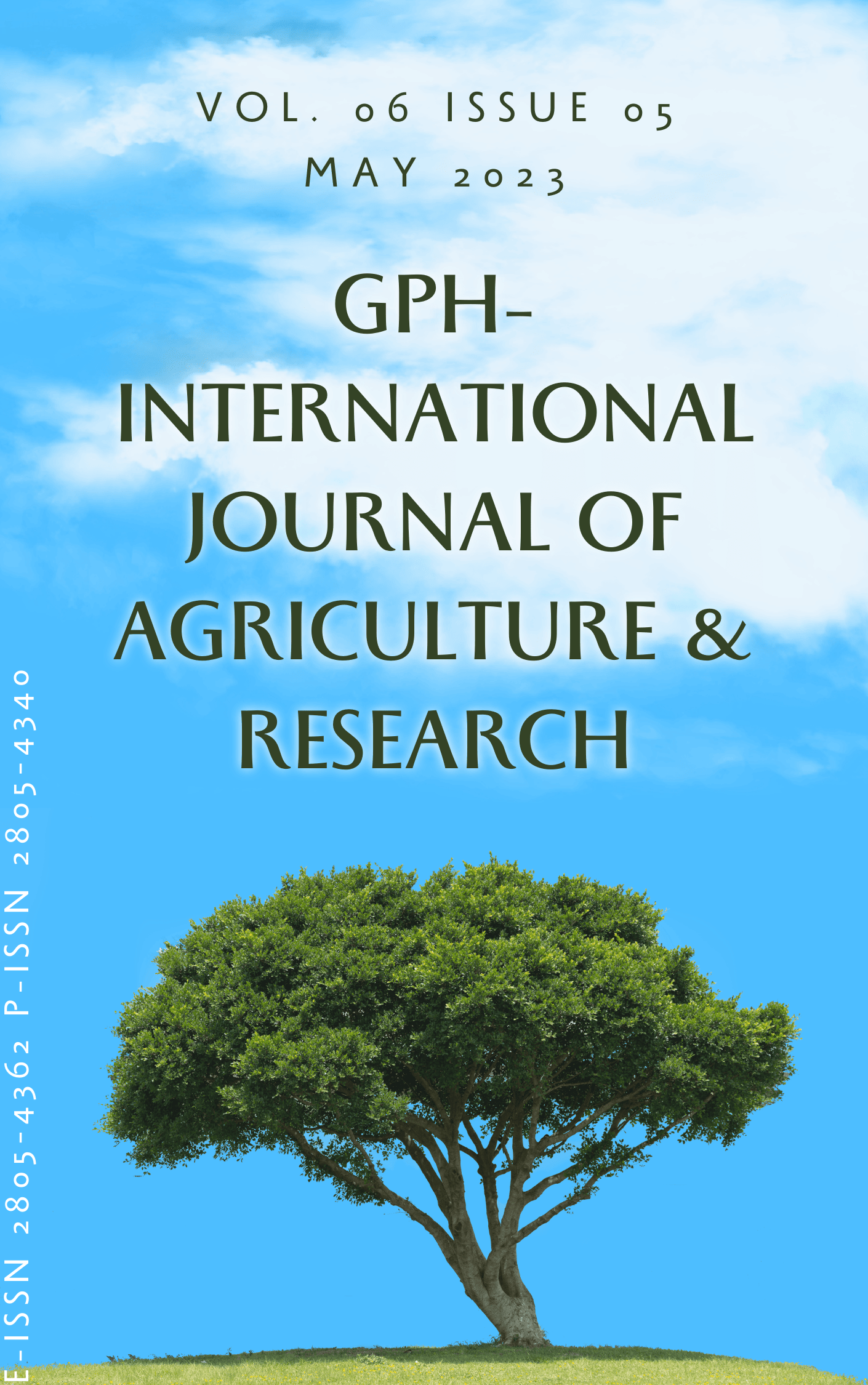ENVIRONMENTALLY FRIENDLY CONTROL OF FALSE SMUT DISEASE [Ustilaginoidea virens (Cooke) Takahashi] IN RICE
Abstract
False smut disease in rice plants is caused by the fungus Ustilaginoidea virens (Cooke) Takahashi, with symptoms of yellow fungal mycelium clustering around the panicles and over time the powder turns black. Exophytic microbes found on leaves have the highest prevalence by Streptomyces sp. and Aspergillus sp. each with 6 isolates (20%), the highest prevalence of exophytic microbes in bauh was Phytophtora sp. as many as 9 isolates (33%) and exophytic microbes on stems with the highest prevalence of Aspergillus flavus as many as 15 isolates (33%). The microbial diversity indices of leaf exophytes, fruit exophytes and stem exophytes were 1.887, 1.369 and 1.617, respectively. Evenness uniformity indices for leaf, fruit and stem exophytes were 0.134, 0.244 and 0.136, respectively. The domination indices of leaf, fruit and stem exophytes were 0.84, 0.74 and 0.76, respectively. This means that the diversity is moderate with small evenness between species and high dominance, there are species that dominate as the highest prevalence mentioned above. Exophytic microbial inhibition in vitro was obtained on leaf exophytes of only Aspergillus sp. by 80 ± 2% and Neurospora sp. by 60 ± 0.7%. In fruit exophytes only Aspergillus sp. can inhibit by 70 ± 0.8%, and the highest stem exophytes by A. flavus by 80 ± 0.9%, followed by Rhizopus sp. by 80 ± 0.4%.
Downloads
References
Biswas, A. (2001). False smut disease of rice: a review. Environment and Ecology, 19, 67–83.
Tanaka, E., T. Ashizawa, R. Sonoda, andC. Tanaka. 2008.Villosiclava virens gen. nov., comb.nov., teleomorph ofUstilaginoidea virens, the causal agent of rice false smut.Mycotaxon, 106, 491–501.
Nithila G., C. Gopalakrishnan, S. Nakkeeran, R. Saraswathi and U. Sivakumar. 2022. Morphological Characterization of False Smut Rice (Ustilaginoidea virens) in Tamil Nadu. J.Res. Angrau 50(4): 01-09.
Sudarma I M., N. W. Suniti and N. N. Darmiati. 2022. Utilization of Exophytic and EndophyticMicrobes in Controlling Alternaria Fruit Rot ofApple (Malus domestica Borkh). GPH Journal of Agriculture and Research 5(08): 19-30.
Saha, R. 2011. Pharmacognosy and pharmacology of Annona squamosal: A review. Int. J. of Phar, & Life Sci. (IJPLS) 2(10): 1183-1189.
Yadav, S.L., A.K. Mishra, P.N. Dongre, and R. Singh. 2011. Assessment of fungixicity of phylloplane fungi against Alternaria brassicae causing leaf spot of mustard. Journal of Agricultural Technology 7(6): 1923-1831.
Sudarma, I M., N.W. Suniti and N.N. Darmiati. 2019. Exophytic and Endophytic Fungus that Potential as Biocontrol Agents onLasiodiplodia theobromae caused Fruit Rot at Sugar-Apple. Int.J.Curr.Microniol.App.Sci. 8(2): 131-142.
Samson, R.A., E.S. Hoekstra, and C. A.N. Van Oorschot. 1981. Introduction to Food-Borne Fungi. Centraalbureau Voor-Schimmelcultures. Institute of The Royal Netherlands. Academic of Arts and Sciences.
Pitt, J.I. and A.D. Hocking. 1997. Fungi and Food Spoilage. Blackie Avademic and Professional. Second Edition. London-Weinhein-New York-Tokyo-Melboune-Madras.
Barnett, H.L. and B.B. Hunter. 1998. Illustrated Genera of Imperfect Fungi. APS Press. The American Phytopathological Sociey. St Paul, Minnesota.
Indrawati. G., R.A. Samson, K. Van den Tweel-Vermeulen, A. Oetari dan I. Santoso. 1999. Pengenalan Kapang Tropik Umum. Yayasan Obor Indonesia. Universitas Indonesia (University of Indonsia Culture Collection) Depok, Indonsia dan Centraalbureau voor Schirmmelcultures, Baarn, The Netherlands (Indonesian language).
Miyadoh, S. 1997. Atlas of Actinomycetes. Asakura Publishing Co Ltd. Japan.
Dolar, F.S. 2001. Antagonistic effect of Aspergillus melleus Yukawa on soilborne pathogens of Chickpea. Tarim Bilimleri Dergisi, 8(2): 167-170.
Mojica-Marin, V., H. A. Luna-Olvera, C. Fco, Sandoval-Coronado, B. Pereyra- Alférez, H. Lilia, Morales-Ramos, E. Carlos, Hernández-Luna and G. O. Alvarado-Gomez. 2008. Antagonistic activity of selected strains of Bacillus thuringiensis against Rhizoctonia solani of chili pepper. African Journal of Biotechnology, 7 (9): 1271-1276.
Odum, E.P. 1971. Fundamentals of Ecology. Third Edition. W.B. Saunders Company.Philadelphia, Toronto, London. Toppan Company, Ltd. Tokyo, Japan.
Pirzan, A.M., dan P. R. Pong-Masak. 2008. Hubungan Keragaman Fitoplankton dengan Kualitas Air di Pulau Bauluang, Kabupaten Takalar, Sulawesi Selatan. Biodiversitas, 9 (3) 217-221 (Indonesian language).
Tauruslina,E,Trizelia ,Yaherwandi dan Hasmiandy ,H. 2015. Analisis keanekaragaman hayati musuh alami pada eksosistem pada sawah di daerah endemik dan non - endemik Wereng Batang Cokelat Nilaparvata lugens di Sumatera Barat. Pros Sem Nas Masy Biodiv Indon 1(3): 581 – 589.
Insafitri, 2010. Keanekaragaman, Keseragaman dan Dominasi Bilvaria di Derah Buangan Lumpur Lapindo Muara Sungai Porong. Jurnal Kelautan: Indonesian Journal of Marine Science and Technology 3(1): 54-59 (Indonesian language).
Adebola, M.O. and Amadi J.E. 2010. Antagonistic activities of Paecilomyces and Rhizopus species against the cocoa black pod pathogen (Phytophthora palmivora). African Scientist 11(4): 235-239.
Copyright (c) 2023 I Made Sudarma

This work is licensed under a Creative Commons Attribution-NonCommercial-NoDerivatives 4.0 International License.
Author(s) and co-author(s) jointly and severally represent and warrant that the Article is original with the author(s) and does not infringe any copyright or violate any other right of any third parties, and that the Article has not been published elsewhere. Author(s) agree to the terms that the GPH Journal will have the full right to remove the published article on any misconduct found in the published article.

























